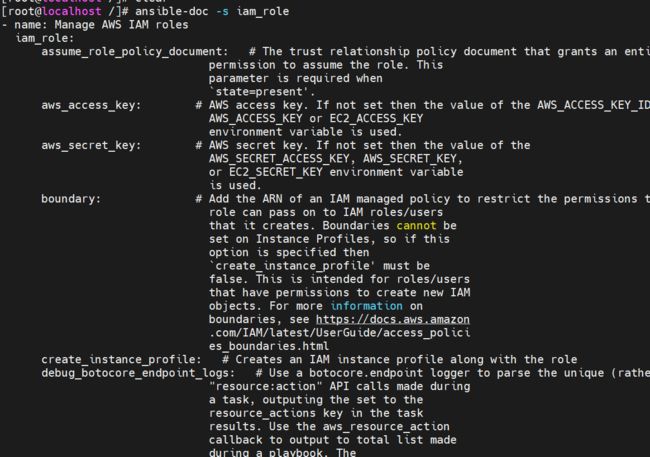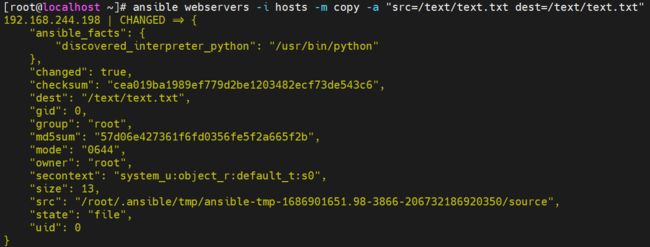Ansible之Ad-Hoc命令
Ad-hoc 命令是什么呢? 这其实是⼀个概念性的名字,是相对于写Ansible playbook 来说的.类似于在命令⾏敲⼊shell命令和 写shell scripts两者之间的关系。可以⽤于执⾏⼀些临时命令。
如果我们敲⼊⼀些命令去⽐较快的完成⼀些事情,⽽不需要将这些执⾏的命令特别保存下来, 这样的命令就叫做 ad-hoc 命令。
Ansible提供两种⽅式去完成任务,⼀是 ad-hoc 命令,⼀是写Ansible playbook。
前者可以解决⼀些简单的任务, 后者解决较复杂的任务,⽐如做配置管理或部署。
1.命令格式
简介:
在快速⼊⻔中执⾏的 Ansible 命令,类似于批量执⾏命令。在Ansible 中统称为Ansible Ad-Hoc。
命令格式如下:
ansible pattern [-i inventory] -m module -a argument
pattern 资产选择器:
- -i 指定资产清单⽂件的位置
- -m 指定本次Ansible ad-hoc 要执⾏的模块。可以类别成
- SHELL 中的命令。
- -a 模块的参数. 可以类⽐成SHELL 中的命令参数
实例:
ansible all -i 192.168.244.188,192.168.244.198 -m copy -a "src=/tmp/a.conf dest=/tmp/a.conf"
意思是将192.168.244.188服务器主机中的/tmp/a.conf复制到192.168.244.198中,并且路径也是/tmp。
2.模块类型
Ansible 模块分三种类型: 核⼼模块(core module)、附加模块(extra module)及⽤户⾃定义模块(consume module)。
核⼼模块是由Ansible 的官⽅团队提供的。
附加模块是由各个社区提供的。例如: OPENSTACK 社区、DOCKER 社区等等。
当核⼼模块和附加模块都⽆法满⾜你的需求时,⽤户可以⾃定义模块。
默认情况下,在安装Ansible 的时候, 核⼼模块和附加模块都已经安装⽽⽆需⽤户⼲预。
3.联机帮助
Ansible 的核⼼模块和附加模块,数量有3000+ 。这样庞⼤的模块数量,对于任何⼀个接触Ansible 的⼈都不可能将其完全记住、掌握使⽤。 因此能够顺利使⽤Ansible 的帮助⽂档,对我们来说是很有必要的。Ansible 的帮助⽂档,由它本身提供的命令 ansible-doc 实现。
常用帮助参数:
a.列举出所有核心模块和附加模块
ansible-doc -l
ansible-doc <modulename>
ansible-doc -s <modulename>
4.常用模块
为了便于演示和操作,现在把之前的测试主机 IP 192.168.244.188和192.168.244.198保存到 当前⽬录下的 hosts ⽂件中。

a.command&shell模块
两个模块都是在远程服务器上去执⾏命令。
但command模块是ad-hoc的默认模块,在执⾏ad-hoc时,若不指定模块的名字则默认使⽤此模块。
ansible all -i hosts -a "echo 'hello'"
ansible all -i hosts -m shell -a "echo 'hello'"
- shell 模块可以执⾏SHELL 的内置命令和 特性(⽐如管道符)
- command 模块⽆法执⾏SHELL 的内置命令和特性
例子:
ansible all -i hosts -m shell -a "echo 'hello'|grep -o 'e'"
ansible all -i hosts -a "echo 'hello'|grep -o 'e'"
b.script模块
将管理节点上的脚本传递到被管理节点(远程服务器)上进⾏执⾏。
例子:
cat /root/a.sh
ansible webservers -i hosts -m script -a "/root/a.sh"
ansible webservers -i hosts -m shell -a "ls -l /tmp/testfile"
c.copy模块
copy 模块的主要⽤于管理节点和被管理节点之间的⽂件拷⻉。
常用参数:
- src 指定拷⻉⽂件的源地址
- dest 指定拷⻉⽂件的⽬标地址
- backup 拷⻉⽂件前,若原⽬标⽂件发⽣了变化,则对⽬标⽂件进⾏备份
- woner 指定新拷⻉⽂件的所有者
- group 指定新拷⻉⽂件的所有组
- mode 指定新拷⻉⽂件的权限
例子:
cat /text/text.txt

copy管理节点上的/text/text.txt到被管理节点上:
ansible webservers -i hosts -m copy -a "src=/text/text.txt dest=/text/text.txt"
ansible webservers -i hosts -m shell -a "ls -l /text/text.txt"
ansible webservers -i hosts -m copy -a "src=/text/text.txt dest=/text/text.txt backup=yes"
copy文件的同时对文件进行用户和用户组设置:
ansible webservers -i hosts -m copy -a "src=/text/text.txt dest=/text/text.txt owner=nobody group=nobody"
copy文件的同时对文件进行权限设置:
ansible webservers -i hosts -m copy -a "src=/text/text.txt dest=/text/text.txt mode=0755"
d.yum_repsitory模块
添加YUM仓库
常用参数:
- name 仓库名称,就是仓库⽂件中第⼀⾏的中括号中名称,必须的参数。
- description 仓库描述信息,添加时必须的参数
- baseurl yum存储库 “repodata” ⽬录所在⽬录的URL,添加
- 时必须的参数。它也可以是多个URL的列表。
- file 仓库⽂件保存到被管理节点的⽂件名,不包含 .repo。默认是 name 的值。
- state preset 确认添加仓库⽂件, absent 确认删除仓库⽂件。
- gpgcheck 是否检查 GPG yes|no, 没有默认值,使⽤/etc/yum.conf 中的配置。
例子–
添加epel源-
ansible dbservers -i hosts -m yum_repository -a "name=epel baseurl='https://download.fedoraproject.org/pub/epel/ $releasever/$basearch/' description='EPEL YUM repo'"
ansible dbservers -i hosts -m yum_repository -a "name=epel state=absent"
e.yum模块
等同于 Linux 上的YUM 命令, 对远程服务器上RPM包进⾏管理。
**常⽤参数: **
- name 要安装的软件包名, 多个软件包以英⽂逗号(,) 隔开
- state 对当前指定的软件安装、移除操作(present installed
- latest absent removed) ⽀持的参数 - present 确认已经安装,但不升级 - installed 确认已经安装 - latest 确保安装,且升级为最新 - absent 和 removed 确认已移除
例子–
安装一个软件包
ansible webservers -i hosts -m yum -a "name=nginx state=present"
ansible webservers -i hosts -m yum -a "name=nginx state=latest"
ansible webservers -i hosts -m yum -a "name=nginx state=installed"
卸载一个软件包
ansible webservers -i hosts -m yum -a "name=nginx state=absent"
ansible webservers -i hosts -m yum -a "name=nginx state=removed"
安装一个软件包组
ansible webservers -i hosts -m yum -a "name='@Development tools' state=present"
f.systemd模块
管理远程节点上的 systemd 服务,就是由 systemd 所管理的服务。
常⽤参数:
- daemon_reload 重新载⼊ systemd,扫描新的或有变动的单元
- enabled 是否开机⾃启动 yes|no
- name 必选项,服务名称 ,⽐如 httpd vsftpd
- state 对当前服务执⾏启动,停⽌、重启、重新加载等操(started,stopped,restarted,reloaded)
例子–
重新加载systemd-
ansible webservers -i hosts -m systemd -a "daemon_reload=yes"
启动nginx服务-
ansible webservers -i hosts -m systemd -a "name=nginx state=started"
关闭nginx服务-
ansible webservers -i hosts -m systemd -a "name=nginx state=stopped"
重启nginx服务-
ansible webservers -i hosts -m systemd -a "name=nginx state=restarted"
重新加载 Nginx 服务-
ansible webservers -i hosts -m systemd -a "name=nginx state=reloaded"
将 Nginx 服务设置开机⾃启动-
ansible webservers -i hosts -m systemd -a "name=nginx enabled=yes"
g.group模块
在被管理节点上,对组进⾏管理。
_常⽤参数: _
- name 组名称, 必须的
- system 是否为系统组, yes/no , 默认是 no
- state 删除或这创建,present/absent ,默认是present
例子–
ansible dbservers -i hosts -m group -a "name=db_admin"
h.user模块
⽤于在被管理节点上对⽤户进⾏管理。
**常⽤参数: **
- name 必须的参数, 指定⽤户名
- password 设置⽤户的密码,这⾥接受的是⼀个加密的值,因为会直接存到 shadow, 默认不设置密码
- update_password 假如设置的密码不同于原密码,则会更新密码. 在 1.3 中被加⼊
- home 指定⽤户的家⽬录
- shell 设置⽤户的 shell
- comment ⽤户的描述信息
- create_home 在创建⽤户时,是否创建其家⽬录。默认创建,假如不创建,设置为 no。2.5版本之前使⽤ createhome
- group 设置⽤户的主组
- groups 将⽤户加⼊到多个其他组中,多个⽤逗号隔开。默认会把⽤户从其他已经加⼊的组中删除。
- append yes|no 和 groups 配合使⽤,yes 时,不会把⽤户从其他已经加⼊的组中删除
- system 设置为 yes 时,将会创建⼀个系统账号
- expires 设置⽤户的过期时间,值为时间戳,会转为为天数后,放在 shadow 的第 8 个字段⾥
- generate_ssh_key 设置为 yes 将会为⽤户⽣成密钥,这不会覆盖原来的密钥
- ssh_key_type 指定⽤户的密钥类型, 默认 rsa, 具体的类型取决于被管理节点
- state 删除或添加⽤户, present 为添加,absent 为删除;默认值 present
- remove 当与 state=absent ⼀起使⽤,删除⼀个⽤户及关联的⽬录,⽐如家⽬录,邮箱⽬录。可选的值为: yes/no
例子–
创建用户并设置密码-
先生成加密密码:
pass=$(echo "123456" | openssl passwd -1 -stdin)
执行ansible命令,创建用户foo并设置密码:
ansible all -i hosts -m user -a "name=foo password=${pass}"
创建⽤户 yangge, 并且为其创建密钥对,并且密钥类型为: ecdsa:
ansible all -i hosts -m user -a "name=yangge generate_ssh_key=yes ssh_key_type=ecdsa"
创建⽤ tom, 并且设置其有效期到 2020年4⽉15⽇, 加⼊到组db_admin 中, 不改变⽤户原有假如的组:
ansible dbservers -i hosts -m user -a "name=tom expires=$(date +%s -d 20200415) gorups=db_admin append=yes"
date 命令说明–
计算 3 ⼩时之后是⼏点⼏分-
date +%T -d '3 hours'
任意⽇期的前 N 天,后 N 天的具体⽇期-
date +%F -d "20190910 1 day"
date +%F -d "20190910 -1 day"
计算两个⽇期相差天数, ⽐如计算⽣⽇距离现在还有多少天-
d1=$(date +%s -d 20180728)
d2=$(date +%s -d 20180726)
echo $(((d1-d2)/86400))
j.file模块
fifile 模块主要⽤于远程主机上的⽂件操作。
常⽤参数:
- owner 定义⽂件/⽬录的属主
- group 定义⽂件/⽬录的属组
- mode 定义⽂件/⽬录的权限
- path 必选项,定义⽂件/⽬录的路径
- recurse 递归的设置⽂件的属性,只对⽬录有效
- src 链接(软/硬)⽂件的源⽂件路径,只应⽤于state=link的情况
- dest 链接⽂件的路径,只应⽤于state=link的情况
- state
- directory 如果⽬录不存在,创建⽬录
- fifile ⽂件不存在,则不会被创建,存在则返回⽂件的信息常⽤于检查⽂件是否存在
- link 创建软链接
- hard 创建硬链接
- touch 如果⽂件不存在,则会创建⼀个新的⽂件,如果⽂件或⽬录已存在,则更新其最后修改时间
- absent 删除⽬录、⽂件或者取消链接⽂件
例子–
创建一个文件-
ansible all -i hosts -m file -a "path=/tmp/foo.conf state=touch"
改变文件所有者及权限-
ansible all -i hosts -m file -a "path=/tmp/foo.conf owner=nobody group=nobody mode=0644"
创建一个软链接-
ansible all -i hosts -m file -a "src=/tmp/foo.conf dest=/tmp/link.conf state=link"
创建一个目录-
ansible all -i hosts -m file -a "path=/tmp/testdir state=directory"
取消一个链接-
ansible all -i hosts -m file -a "path=/tmp/link.conf state=absent"
删除一个文件-
ansible all -i hosts -m file -a "path=/tmp/foo.conf state=absent"
k.cron模块
管理远程节点的CRON 服务。等同于Linux 中的 计划任务。
**PS:**使⽤ Ansible 创建的计划任务,是不能使⽤本地crontab -e去编辑,否则 Ansible ⽆法再次操作此计划任务了。
常⽤参数:
- name 指定⼀个cron job 的名字。⼀定要指定,便于⽇之后删除。
- minute 指定分钟,可以设置成(0-59, *, /2 等)格式。 默认是 , 也就是每分钟。
- hour 指定⼩时,可以设置成(0-23, *, */2 等)格式。 默认是 * ,也就是每⼩时。
- day 指定天, 可以设置成(1-31, *, */2 等)格式。 默认是 * , 也就是每天。
- month 指定⽉份, 可以设置成(1-12, *, /2 等)格式。 默认是 , 也就是每周。
- weekday 指定星期, 可以设置成(0-6 for Sunday-Saturday, *等)格式。默认是 *,也就是每星期。
- job 指定要执⾏的内容,通常可以写个脚本,或者⼀段内容。
- state 指定这个job的状态,可以是新增(present)或者是删除(absent)。 默认为新增(present)
例子–
新建一个CRON JOB任务-
ansible all -i hosts -m cron -a "name='create new job' minute='0' job='ls -alh > /dev/null'"
删除⼀个 CRON JOB 任务,删除时,⼀定要正确指定job 的name参数,以免误删除-
ansible all -i hosts -m cron -a "name='create new job' state=absent"
登录任何⼀台管理机验证cron-
crontab -l
Ansible: create new job
l.debug模块
debug 模块主要⽤于调试时使⽤,通常的作⽤是将⼀个变量的值给打印出来。
常⽤参数–
- var 直接打印⼀个指定的变量值
- msg 打印⼀段可以格式化的字符串
例子–
这⾥引⼊了变量,我们只需了解 debug 模板的使⽤即可。在学习变量、剧本时,我们会对它有更深刻的理解
ansible all -i hosts -m debug -a "var=role" -e "role=web"
ansible all -i hosts -m debug -a "msg='role is {{role}} '" -e "role=web"
m.template 模块
template 模块使⽤了Jinjia2格式作为⽂件模版,可以进⾏⽂档内
变量的替换。⽂件以 .j2 结尾。
常⽤参数–
- src 指定 Ansible 控制端的 ⽂件路径
- dest 指定 Ansible 被控端的 ⽂件路径
- owner 指定⽂件的属主
- group 指定⽂件的属组
- mode 指定⽂件的权限
- backup 创建⼀个包含时间戳信息的备份⽂件,这样如果您以某种⽅式错误地破坏了原始⽂件, 就可以将其恢复原状。 yes/no
例子–
_ _ ⽤法其实和 copy 模块基本⼀样, template 模块的强⼤之处就是使⽤变量替换,就是可以把传递给 Ansible 的变量的值替换到模板⽂件中。
建立一个template文件,名为hello_world.j2
cat hello_world.j2
ansible all -i hosts -m template -a "src=hello_world.j2 dest=/text/hello_world.world" -e "var=world"
在被控主机上验证
cat /text/hello_world.world
n.** lineinfifile 模块**
在被管理节点上,⽤正则匹配的⽅式对⽬标⽂件的⼀⾏内容修改删除等操作。
如果是在⼀个⽂件中把所有匹配到的多⾏都进⾏统⼀处理,请参考replace 模块。
如果想对⼀个⽂件进⾏⼀次性添加/更新/删除多⾏内容等操作,参考blockinfifile模块
常⽤参数–
- path 被管理节点的⽬标⽂件路径, 必须。
- state 可选值absent 删除 |present 替换(默认值)。
- regexp 在⽂件的每⼀⾏中查找的正则表达式。
- 对于 state=present ,仅找到的最后⼀⾏将被替换。
- line 要在⽂件中插⼊/替换的⾏。需要state=present。
- create ⽂件不存在时,是否要创建⽂件并添加内容。yes/no
例子–
删除被控节点⽂件⾥的某⼀条内容-
ansible dbservers -i hosts -m lineinfile -a "path=/etc/sudoers regexp='^%wheel' state=absent"
替换某⼀⾏-
ansible dbservers -i hosts -m lineinfile -a "path=/etc/selinux/config regexp='^SELINUX=' line='SELINUX=disabled' state=present"
o.blockinfifile 模块
对⽬标⽂件进⾏多⾏的添加/更新/删除操作
常⽤参数–
- path ⽬标⽂件路径
- block ⽂件中被操作的块内容
- state 块内容如何处理,absent 删除, present 添加/更新(默认值)
例子–
**_ _**向⽂件/etc/ssh/sshd_config的最后添加⼏⾏内容添加的内容是
Match User ansible-agent
PasswordAuthentication no
ansible dbservers -i hosts -m blockinfile -a "path=/etc/ssh/sshd_config block='Match User ansible-agent\nPasswordAuthentication no'"
更新之前的内容-
ansible dbservers -i hosts -m blockinfile -a "path=/etc/ssh/sshd_config block='Match User ansible-agent\nPasswordAuthentication yes'"
删除⽂件中的连续出现⼏⾏内容-
ansible dbservers -i hosts -m blockinfile -a "path=/etc/ssh/sshd_config block='Match User ansible-agent\nPasswordAuthentication yes' state=absent











